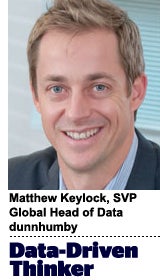 “Data-Driven Thinking” is written by members of the media community and contains fresh ideas on the digital revolution in media.
“Data-Driven Thinking” is written by members of the media community and contains fresh ideas on the digital revolution in media.
Today’s column is written by Matthew Keylock, senior vice president and global head of data at dunnhumby.
There has been a veritable explosion of new CxO titles in the last decade. We now seem to have them for so many things, such as experience, revenue, customer, knowledge, compliance, technology, science, creative, digital, risk and so on.
Few could argue that the term “officer” is being applied in its correct sense in many cases. Companies need executive-level leadership in areas vital to their organization.
Although we are in the big data era and big consulting firms tell us that data-driven businesses outperform their peers, not every business needs to jump on the bandwagon and go hire a chief data officer.
The truth is that if done right, data drives insight, enables smart strategies and drives aligned execution based on a deeper understanding of your customer. As a young(ish) data-savvy marketing executive 10 years ago, I still clearly recall being told by a powerful retail CIO that data was important, but ultimately was “just like the fuel in the car.” Today, companies that have strong strategies and tactics for that fuel are winning.
The challenge is that, for some businesses, it is not as straightforward as it used to be.
Four Shifts
Gone are the days when corporate data was limited to financial, production, distribution and employee data generated by operational systems. These data sets seem so simple now as we look back from our current perspective: Numeric and often hierarchical data was generally easy to structure, predict and manage. It was typically only in the opaque, weird and wonderful world of marketing that there was other information – like research survey data, third-party proprietary data and panel data – that didn’t easily fit. So it was left alone.
Some businesses can still thrive with this approach. It depends a lot on the business and sector they are in and their strategy to win. For many other companies, four things have shifted that have elevated the challenge to a whole new level:
1. The need to know customers as individuals in the data
This has changed dramatically in the past 15 years. The realization that financial and sales data only provide the “what,” and not the “who” and the “why,” wasn’t always there. Competitive advantage has come to those who have used customer data to drive strategy and activation. But this is not easy.
I won’t go into the all the details here, but the customer dimension in data is not a simple one to deal with. First, there’s the organizational challenge of regarding the customer as a horizontal dimension across the enterprise, rather than taking a vertical department view. This makes alignment on use of data much harder. There are technical challenges, too. Unlike other entities or with products, such as a soda, customers can’t be simply organized into neat, structured hierarchies. They are unique from each other and over time and space; they are not always rational.
2. We’ve gone digital
Customer expectations have changed massively, and the trajectory is increasing. The corresponding explosion in the amount, types, speed and silos of data, along with a lack of structure to some of it, is creating a multiplex of challenges. It can be difficult to wrap your brain around this data, let alone a whole organization.
3. Disintermediation and the blurring of boundaries
Opportunities and threats are lurking around every corner. Data is increasingly powerful for anticipating and overcoming threats, as well as for unlocking new opportunities, or being the reason your company and not a competitor can win a given opportunity. Through data, business can reach beyond its existing boundaries to drive new influence, collaborations and growth not previously possible.
4. Today, everyone can “do” data
It used to only be a few people in the business with the skills to write code to manipulate data. Today, every department has its data-savvy analysts, scientists or engineers. This significant step forward brings some new challenges, too. As the saying goes, a little knowledge can be a dangerous thing. It can also lead to random acts and duplicative efforts, and to missing bigger opportunities.
The Roots Of The Problem
These challenges are complex. How they are addressed can make or break an organization. How do they commonly manifest?
First, there is the problem of a fragmented data view of the customer, with more islands of data.
We’ve seen an explosion of unintegrated external insight suppliers, creating external islands of data, too.
This leads to a diluted strategy, slower insights and exhausting decisions. All the fragmented islands of data aren’t creating clear insight.
Antagonistic and contentious actions also play a role, with insights and algorithms unknowingly conflicting.
There can be duplication of effort and spending, resulting in overlapping work and repeated work without the right data leadership.
Finally, there are limitations to only incremental thinking where nobody is solving for the big questions, such as “How will we win when customers control their own data?” and “Can my data drive new business models or avenues of growth?”
The Case For A CDO
Addressing all of these matters require a CDO. They aren’t simply an extension of an IT department’s data architecture or master data-management function. The data leader needs to blend expertise in these areas with data science, insight, marketing and strategy. They also need an in-depth understanding of the business and credibility across the organization. They need to call on these skills to solve for today’s needs and bring to life the art of the possible.
Adding the role to existing IT or marketing teams can cloak it in existing politics and legacy expectations that add extra hurdles to overcome before the leader can even get to the start line. This doesn’t have to be the case. It is vital that the whole leadership team sets up this role to succeed, and removes barriers in order to enable the rewards this role can bring.
I’ve mulled over the data-as-fuel analogy a lot since the coaching from that retail CIO, and there’s one angle of this I do relate to: I see IT departments and the large technology providers all busily designing and building the next car to go a bit faster. But the big leaps forward in transportation don’t come from a better car; they come from a new fuel, just as we made the jump from steam to gasoline.
Developing cleaner and better fuel is the challenge of data heads, whether the title is CDO or something else. But the real leap forward for the business – and the industry – will come when the next energy source is created or discovered.
Anything less is merely following the leader, not being the leader.
Follow Matt Keylock (@mattkeylock) and AdExchanger (@adexchanger) on Twitter.












